If you’re looking for essential environmental law books in 2025, I recommend starting with foundational works like “Natures Trust” and “Environmental Law: A Very Short Introduction” to grasp core principles. Practical guides such as “Preparing NEPA Environmental Assessments” and “Environmental Impact Assessment” will sharpen your skills, while case studies like “Fire Weather” and “Exposure” offer real-world insights. Don’t miss influential titles on sustainability and policy reform—there’s a lot to absorb to make a true impact. Keep going to uncover even more.
Key Takeaways
- Foundational texts like *Nature’s Trust* provide environmental ethics, legal principles, and advocacy frameworks essential for environmental advocates.
- Practical guides such as *Preparing NEPA Environmental Assessments* and *Environmental Impact Assessment* offer essential tools for effective impact analysis and legal compliance.
- Introductory resources like *Environmental Law: A Very Short Introduction* help newcomers grasp complex legal concepts quickly.
- Field guides and advocacy literature, including *The Laws Field Guide to the Sierra Nevada* and *Poisoned*, support environmental education and public awareness efforts.
- Updated, comprehensive titles are recommended for staying current with evolving laws and policies in environmental advocacy in 2025.
Natures Trust: Environmental Law for a New Ecological Age
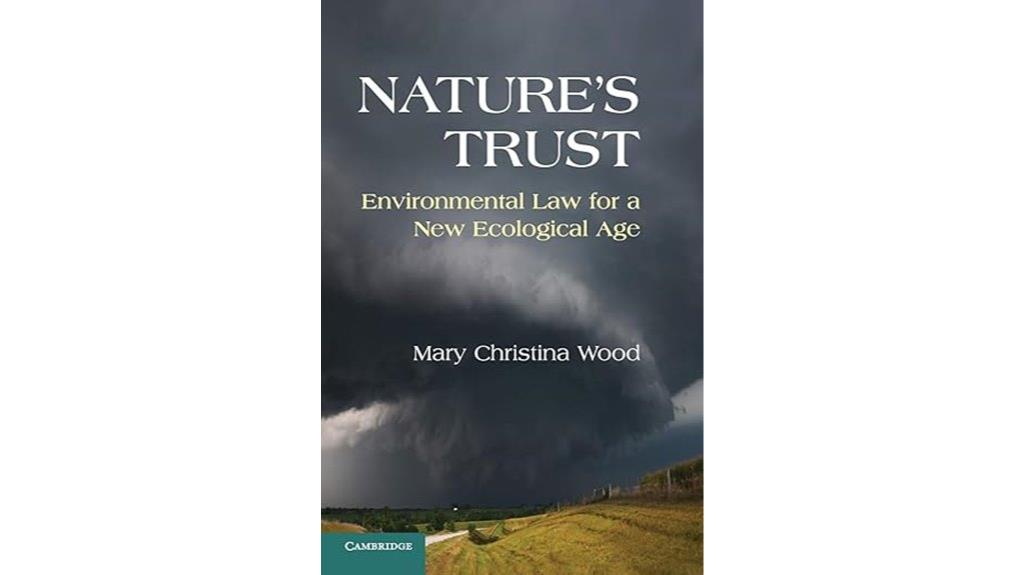
If you’re seeking a foundational book that explores the roots and future of environmental law, “Nature’s Trust: Environmental Law for a New Ecological Age” is a must-read. Professor Mary Christina Wood traces environmental stewardship from indigenous values, Roman law, and the U.S. Constitution to today’s crises. She emphasizes the fiduciary duty of government to protect natural assets for current and future generations, framing these resources as a trust. The book highlights how legal and moral principles underpin ecological responsibility and advocates for a societal shift—what she calls the “Great Transition”—to restore governance, enforce trusteeship, and ensure sustainability for all.
Best For: individuals, policymakers, and environmental advocates seeking a comprehensive understanding of the roots, current challenges, and future legal pathways for ecological stewardship rooted in natural law and moral responsibility.
Pros:
- Provides a thorough historical and legal foundation for environmental stewardship and the concept of Nature’s Trust
- Emphasizes moral principles and societal responsibility, inspiring active citizen engagement and legal reform
- Offers practical insights into how courts and laws can be reoriented to prioritize ecological sustainability and intergenerational justice
Cons:
- The dense and theoretical nature of the content may be challenging for readers seeking quick or simplified summaries
- Implementation of the proposed legal and societal shifts may require extensive systemic reform and political will, which could be slow to realize
- May require readers to have prior knowledge of legal, environmental, and constitutional concepts for full comprehension
Environmental Law: A Very Short Introduction (Very Short Introductions)
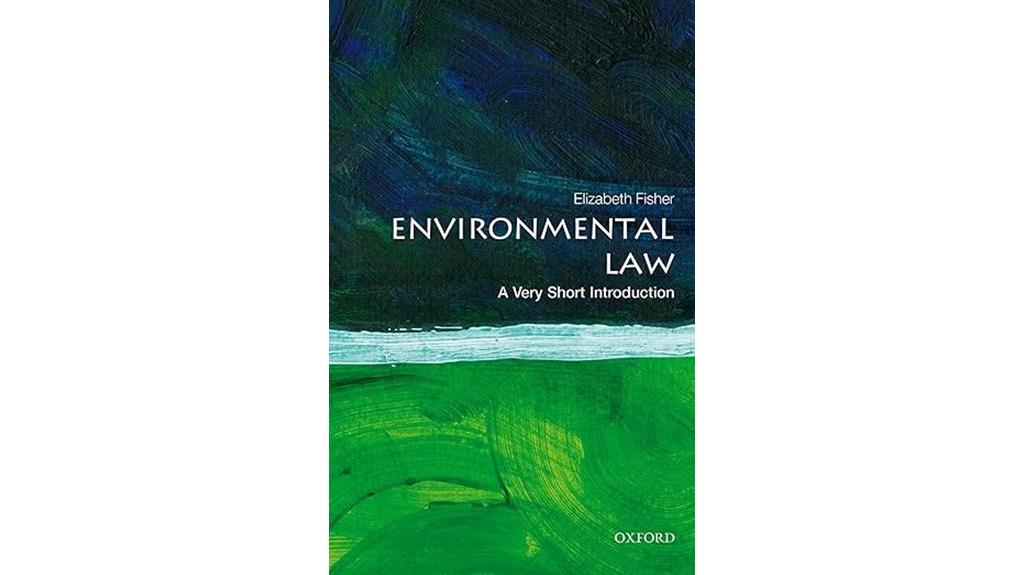
Environmental Law: A Very Short Introduction stands out as an ideal choice for anyone new to environmental issues who wants a clear, straightforward overview of legal concepts. I appreciate how it makes complex topics accessible to non-lawyers, helping readers recognize environmental problems in their lives and guiding them on legal options. The book covers the evolution of environmental laws, themes of power and justice, and expands legal imagination, all in an engaging way. While it doesn’t explore international frameworks or real case examples, its practical focus and ease of understanding make it a valuable starting point for anyone interested in environmental advocacy.
Best For: individuals new to environmental issues seeking a clear, accessible introduction to environmental law concepts.
Pros:
- Makes complex legal topics understandable for laypersons
- Covers historical development and themes of power and justice in environmental law
- Practical focus on helping readers recognize legal options for environmental issues
Cons:
- Does not address international or regional human rights frameworks related to environmental law
- Lacks real-world case examples demonstrating legal challenges and successes
- May not provide in-depth analysis suitable for legal professionals or advanced students
Preparing NEPA Environmental Assessments: A User’s Guide

Preparing NEPA Environmental Assessments: A User’s Guide stands out as the top choice for professionals responsible for creating legally defensible and high-quality Environmental Assessments. I’ve found it invaluable for its clear, practical guidance grounded in years of experience. The authors, Eccleston and Daub, offer trusted insights that help guarantee consistency and compliance across projects, especially within agencies like the Department of Energy. While it emphasizes specific agency practices, its strong focus on best practices makes it a must-have reference for anyone involved in NEPA assessments. This guide’s practical approach and proven effectiveness make it an essential tool for advocates seeking to master NEPA processes.
Best For: professionals responsible for developing legally defensible, high-quality NEPA Environmental Assessments seeking practical guidance rooted in proven best practices.
Pros:
- Offers clear, practical guidance based on extensive experience to ensure consistency and compliance.
- Highly regarded by NEPA managers and staff for its utility and effectiveness.
- Focuses on best professional practices, making it a trusted resource for producing defensible EAs.
Cons:
- Heavy emphasis on Department of Energy projects and procedures, which may limit broader applicability.
- Frequent references to related works and agency-specific procedures could reduce clarity for some readers.
- The author’s extensive discussion of other publications may detract from the core content of NEPA assessment practices.
Environmental Impact Assessment: A Guide to Best Professional Practices

Environmental Impact Assessment: A Guide to Best Professional Practices stands out as an essential resource for practitioners, students, and professionals seeking thorough guidance on conducting credible and defensible EIAs. I find this book invaluable because it covers key disciplines encountered in NEPA and EIA, offering detailed insights into impact assessment, document preparation, and evaluation of cumulative effects. Authors Cantor and Eccleston provide clear, practical advice on tackling controversial issues like climate change and environmental justice, emphasizing evidence-based analysis and professional standards. This exhaustive guide improves my understanding of best practices, ensuring I can produce reliable, defensible impact assessments that support sustainable decision-making.
Best For: environmental professionals, students, and decision-makers seeking comprehensive guidance on conducting credible and effective Environmental Impact Assessments.
Pros:
- Provides detailed, practical guidance on impact assessment, documentation, and evaluation of cumulative effects.
- Offers expert insights on addressing controversial issues like climate change and environmental justice.
- Emphasizes evidence-based analysis and adherence to professional standards, ensuring credible results.
Cons:
- The extensive scope may be overwhelming for beginners or those new to EIA practices.
- Some content may require prior knowledge of environmental policies and technical terminology.
- The detailed focus on best practices might limit quick-reference or simplified approaches for urgent assessments.
Emanuel Law Outlines for Environmental Law (Emanual Law Outlines)
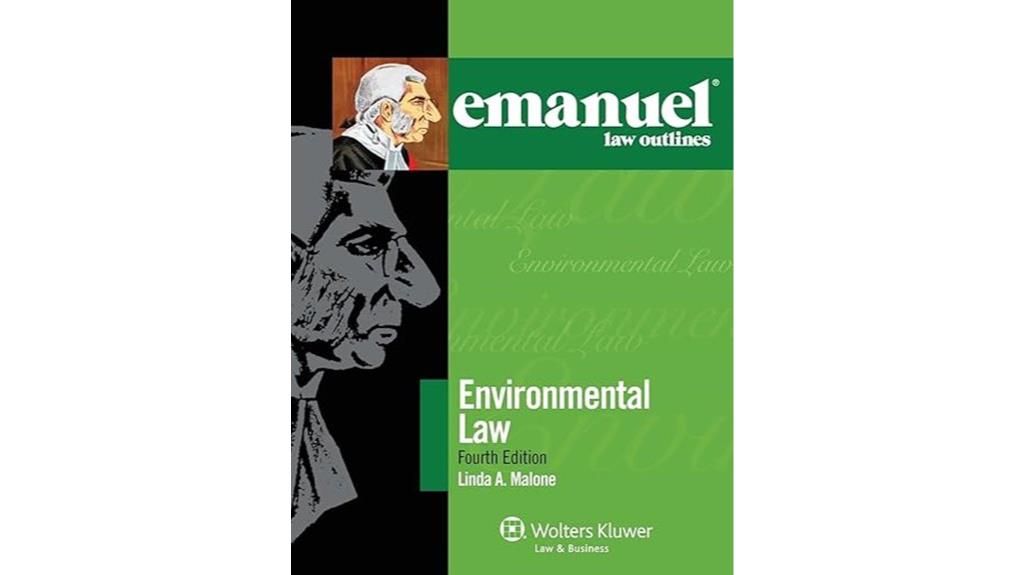
If you’re starting your environmental law studies or need a clear, straightforward reference, Emanuel Law Outlines for Environmental Law is an excellent choice. I find it to be a highly recommended study tool, especially useful for foundational understanding. The explanations are simple, helpful, and make complex topics like the Clean Air Act more accessible. While it covers general concepts well, it doesn’t explore deeply into specifics like NEPA, CAA, or recent legislative updates. It offers helpful citations to legislation, making legal research easier. Just remember, it’s best used alongside other detailed resources, particularly for case law and current developments.
Best For: students or beginners seeking a straightforward, foundational overview of environmental law concepts and legislation.
Pros:
- Provides clear, simple explanations ideal for initial understanding
- Includes citations to relevant legislation, aiding legal research
- Useful as a quick reference for complex topics like the Clean Air Act
Cons:
- Lacks in-depth coverage of specific regulations such as NEPA, CAA, and CWA
- Not updated with recent legislative developments or case law
- Should be supplemented with more detailed, current resources for comprehensive study
The Laws Field Guide to the Sierra Nevada (California Academy of Sciences)

The Laws Field Guide to the Sierra Nevada stands out as an essential resource for naturalists, hikers, and outdoor enthusiasts exploring California’s diverse landscape. It offers extensive coverage of local flora and fauna, with detailed illustrations, helpful distribution maps, and identification tips. The guide is well-organized, durable, and easy to use in the field, even during long hikes. Its visuals profoundly aid species recognition, fostering a deeper appreciation for nature. While some updates are needed for taxonomy, it remains a reliable starting point. Overall, I find it invaluable for enhancing outdoor experiences and connecting more meaningfully with Sierra Nevada’s environment.
Best For: outdoor enthusiasts, naturalists, and hikers seeking a comprehensive and durable field guide to California’s Sierra Nevada flora and fauna.
Pros:
- Extensive coverage with detailed illustrations and helpful distribution maps.
- Well-organized, easy to navigate, and durable for outdoor use.
- Enhances species recognition and fosters a deeper appreciation for nature.
Cons:
- Some taxonomic updates and scientific names are outdated.
- Lacks detailed information on mushroom edibility and toxicity.
- Limited scope for in-depth identification of certain species, requiring supplementary guides.
Poisoned: How a Prosecutor Turned His Medical Mystery into an Environmental Victims Crusade
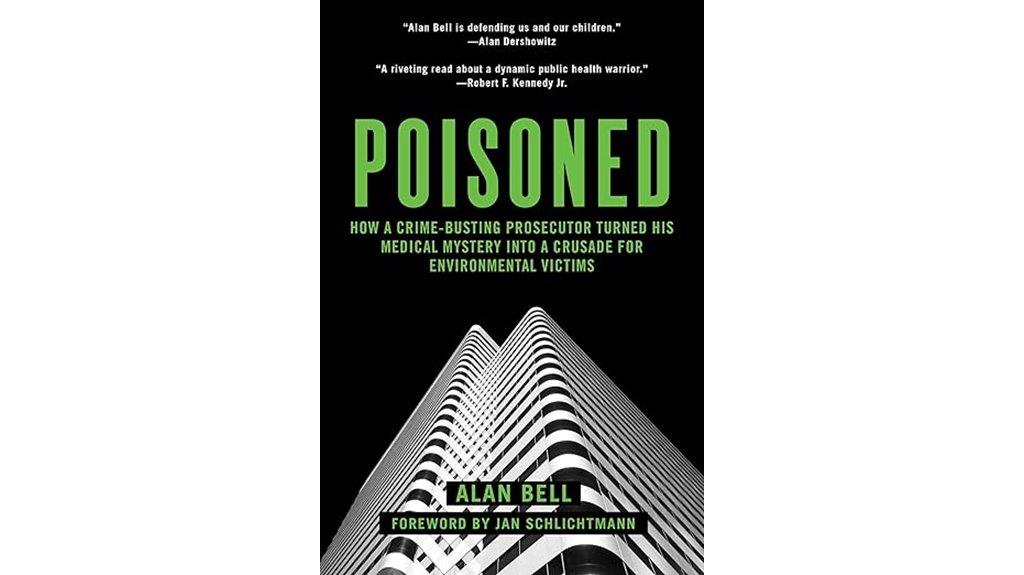
Poisoned stands out for anyone interested in understanding how individual activism can challenge corporate and regulatory failures to protect public health. This book reveals the hidden dangers of unregulated chemicals in everyday products—food, water, air, toys, and household items—that often go unnoticed. The author’s personal battle with mysterious illness highlights how chemical exposure harms vulnerable populations, especially children. As a prosecutor turned activist, he exposes systemic neglect and corporate denial. His story shows that persistent advocacy and consumer awareness can push for stronger regulations. It’s a compelling call to action, demonstrating that individual efforts can challenge powerful industries and protect public health.
Best For: Individuals concerned about environmental toxins, health advocates, and anyone interested in learning how activism can drive regulatory change for safer products.
Pros:
- Provides a thorough, well-documented exploration of unregulated chemicals in everyday life.
- Shares inspiring personal stories that foster empathy and motivation for activism.
- Offers practical resources and insights for readers to become more informed and proactive.
Cons:
- Some readers may find the detailed regulatory and chemical information complex or dense.
- The book focuses heavily on advocacy, which might be less appealing to those seeking purely scientific data.
- It may require a willingness to confront uncomfortable truths about environmental and corporate neglect.
The New Environmental Regulation

Are you seeking a thorough understanding of how recent reforms are shaping environmental regulation? I’ve studied experts like Daniel Fiorino, who critiques outdated 1970s laws that viewed environmental protection and business interests as zero-sum. He highlights that Europe, especially countries like the Netherlands and Sweden, shows how environmental goals can align with industrial strength. Fiorino advocates for integrating voluntary programs into core regulation and embracing systemic reforms. His insights challenge us to rethink top-down, compliance-focused models, emphasizing innovative policies that promote sustainability without sacrificing economic significance. These ideas are essential for understanding the evolving landscape of environmental regulation today.
Best For: policymakers, environmental advocates, and students seeking innovative approaches to modern environmental regulation that balance sustainability with economic strength.
Pros:
- Encourages systemic reforms and integration of voluntary programs into core regulation for more effective environmental management.
- Draws on successful European models, demonstrating that environmental protection can coexist with strong industrial sectors.
- Promotes a shift away from outdated, compliance-focused, top-down regulatory approaches toward innovative, sustainable solutions.
Cons:
- Comparing U.S. policies to European countries like Sweden and the Netherlands may oversimplify complex socio-economic contexts.
- Implementing systemic reforms and integrating voluntary programs may face resistance within existing bureaucratic structures.
- Relying on new approaches requires significant political will and resources, which may not be readily available in all jurisdictions.
Fire Weather: On the Front Lines of a Burning World
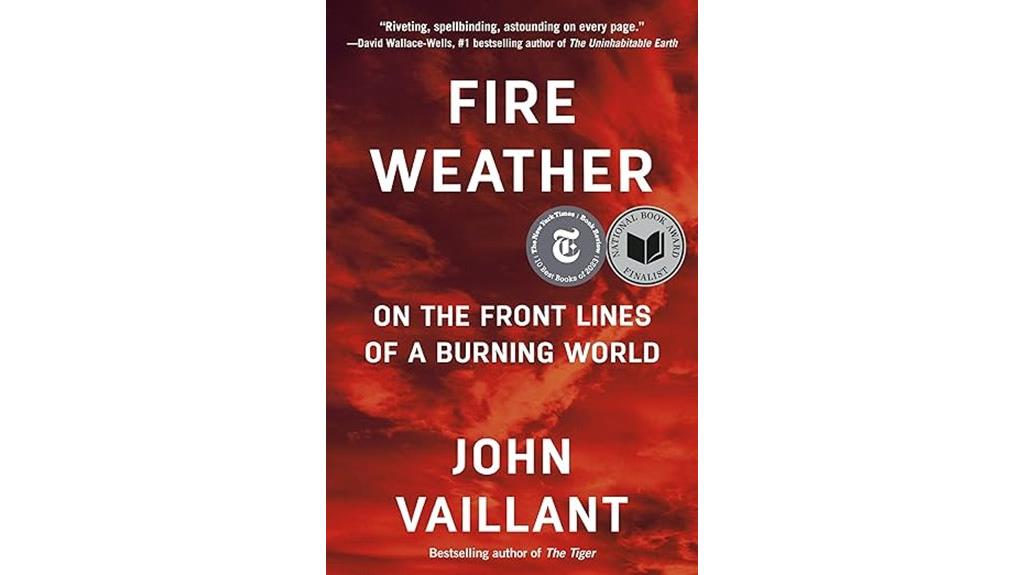
If you’re seeking a compelling account of how climate change fuels wildfires and affects our planet, “Fire Weather” by John Vaillant offers invaluable insights. It traces fire’s history and shows how recent mega-fires, like Canada’s 2016 Fort McMurray blaze, are signs of a warming world. Vaillant combines scientific data, historical context, and personal stories to highlight human reliance on fossil fuels and the environmental toll of industry. The book emphasizes that climate change is a slow-moving disaster, yet it also reveals Earth’s resilience. It calls for urgent action, societal reflection, and policy change to address the escalating threat of wildfires driven by climate instability.
Best For: readers interested in understanding the connection between climate change and wildfires, environmental advocates, and those seeking a detailed analysis of fire’s historical and scientific context.
Pros:
- Provides a comprehensive, well-researched overview of fire’s role in Earth’s ecosystems and climate change.
- Combines scientific data, historical events, and personal stories for an engaging and informative reading experience.
- Highlights the urgency of societal and policy changes needed to combat climate-driven wildfires and environmental degradation.
Cons:
- The bleak outlook on climate change may feel overwhelming or discouraging to some readers.
- Dense scientific and historical details might be challenging for casual readers or those new to environmental topics.
- Focus on global and Canadian fire events may limit relevance for readers interested in other regional wildfire issues.
Exposure: Poisoned Water, Corporate Greed, and One Lawyers Twenty-Year Battle against DuPont
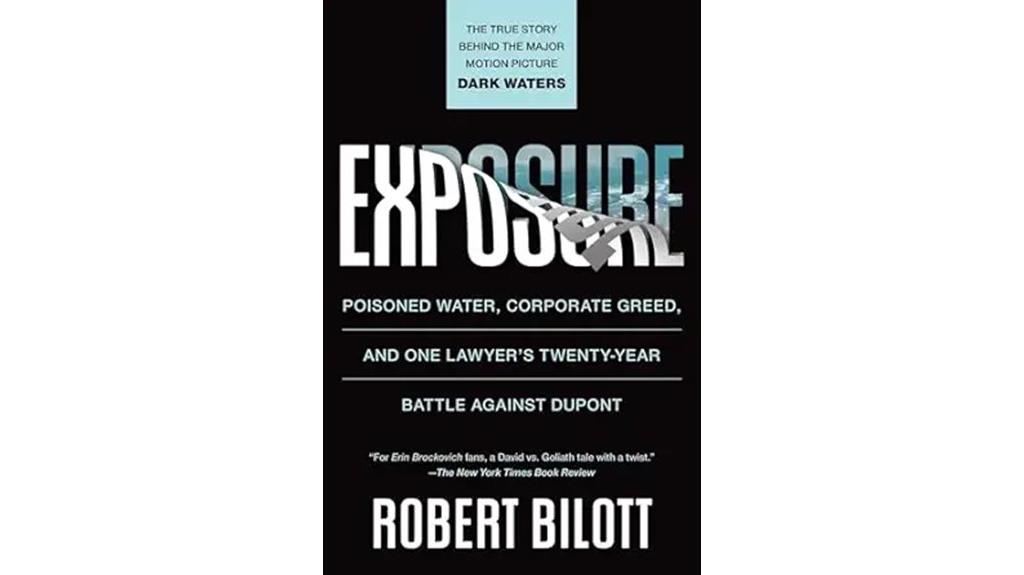
Anyone interested in understanding the complexities of environmental justice and corporate accountability will find this story particularly compelling. Over two decades, lawyer Robert Bilott fought DuPont’s pollution and deception, exposing how chemicals like PFAS contaminated water supplies nationwide. Despite corporate cover-ups and regulatory hurdles, his relentless legal battle revealed deadly health risks and environmental harm. DuPont’s greed led to illegal dumping, causing illnesses and deaths, and resulting in a $670 million settlement. This story highlights the devastating impact of corporate misconduct, regulatory failures, and the power of perseverance. It’s a stark reminder of the importance of vigilance, transparency, and advocating for stronger protections in environmental law.
Best For: individuals interested in environmental justice, legal battles against corporate pollution, and awareness of chemical safety issues.
Pros:
- Provides an in-depth understanding of the complex interplay between corporate misconduct and environmental health.
- Highlights inspiring stories of perseverance and legal advocacy that promote awareness and activism.
- Combines scientific, legal, and personal narratives to create a compelling and accessible account.
Cons:
- May be emotionally intense due to detailed descriptions of health impacts and environmental damage.
- Could be dense for readers unfamiliar with legal or scientific terminology.
- Focus primarily on one case study may limit perspectives on broader environmental issues.

The Sustainability Handbook stands out as an essential resource for sustainability professionals and organizational leaders seeking practical guidance on integrating social, economic, and environmental responsibility into their operations. I find it highly valuable for its all-encompassing approach, covering core concepts, challenges, and achievable goals. The book offers practical advice, case studies, and tools that help translate sustainability principles into action across sectors like NGOs, government, and small businesses. While some parts are dense, its detailed appendices and standards make it a practical manual. If you’re serious about operationalizing sustainability strategies, this book provides a solid foundation to inform your efforts and foster meaningful change.
Best For: sustainability professionals, organizational leaders, and students seeking comprehensive, practical guidance on integrating social, economic, and environmental responsibility into various sectors.
Pros:
- Extensive coverage of core sustainability concepts, challenges, and achievable goals.
- Practical advice, case studies, and tools that facilitate real-world application.
- Valuable appendices with standards, reference materials, and cost-cutting tips.
Cons:
- Lengthy and detailed content may be overwhelming for some readers.
- Some examples and case studies are outdated, limiting current relevance.
- Chapters could be more concise to improve readability and engagement.
Factors to Consider When Choosing Environmental Law Books

When selecting environmental law books, I focus on how well they match my interests and needs. I also consider the depth of content, practical use, the author’s expertise, and whether the information is current. These factors help me choose books that are both relevant and reliable for my purposes.
Relevance to Interests
Choosing the right environmental law book starts with guaranteeing its focus aligns with your specific interests, whether that’s climate change, pollution control, or ecological justice. I look for books that address the legal frameworks and principles relevant to my region or jurisdiction to ensure applicability. It’s also important that the material covers recent legal developments and current issues, so I stay updated on the latest trends and challenges. I prefer resources that include practical legal strategies or case studies that resonate with my professional or personal goals. Additionally, I consider whether the book reflects the ethical, moral, or cultural values I prioritize in environmental stewardship. This alignment helps me find resources that are not only informative but also meaningful and actionable in my advocacy work.
Depth of Content
Evaluating the depth of content in an environmental law book is crucial to guaranteeing it meets your learning and professional needs. I look for books that offer extensive coverage of key laws like NEPA, CAA, and CWA, providing a broad understanding of regulatory frameworks. It’s also important that the content dives into legal principles, case law, and statutory interpretation, matching my desired level of legal analysis. I check if the book includes historical context and policy critiques to understand how laws have evolved and their effectiveness. For more advanced insights, I consider whether it discusses emerging issues like climate change, environmental justice, and international law. Ultimately, I assess the technical detail and legal terminology to ensure they align with my familiarity and learning goals.
Practical Application
Selecting an environmental law book that emphasizes practical application is essential for translating legal principles into real-world solutions. I look for books that include case studies, step-by-step procedures, or practical guidance that helps apply legal concepts to actual environmental issues. It’s important that the book offers templates, checklists, or tools to assist with drafting, reviewing, and enforcing regulations effectively. I also evaluate whether the content addresses current legal standards and features recent examples of legal challenges and solutions to ensure relevance. Additionally, I appreciate books that discuss integrating legal strategies with scientific data, advocacy techniques, and policy development. Finally, the best practical guides help navigate regulatory agencies, understand compliance, and implement best practices—crucial for effective environmental legal work.
Author Expertise
When exploring environmental law books, one of the most important factors to contemplate is the author’s expertise. An author’s background in law, policy, or scientific research guarantees the book offers accurate, credible information. Experts with practical experience in law implementation or policy reform can provide valuable insights into real-world challenges and solutions. Authors affiliated with academic or government institutions often include thorough legal analysis and references to current legislation, enhancing the book’s authority. Recognized authorities in the field lend credibility and increase the likelihood that the book will be valued in academic and professional settings. Understanding an author’s expertise helps me gauge the depth of legal detail and relevance to contemporary environmental issues, making my selection more informed and impactful.
Up-to-Date Information
To stay current with environmental law, I always check that the book covers recent legal developments, amendments, and landmark court decisions. It’s essential that the publication cites the latest regulations, statutes, and international agreements to reflect the evolving legal landscape. I also verify the publication date and edition to guarantee it includes recent policy changes and emerging issues like climate change legislation, pollution controls, and sustainability mandates. Additionally, I look for discussions on recent case law and judicial interpretations to understand how courts are applying laws today. Up-to-date information assures I’m equipped with relevant and accurate insights, allowing me to stay ahead in advocacy and legal practice. Choosing a book that incorporates these elements keeps me well-informed and prepared for current environmental challenges.
Frequently Asked Questions
How Do These Books Address Emerging Environmental Legal Challenges?
These books address emerging environmental legal challenges by analyzing recent case law, policy shifts, and technological impacts. I find they offer practical strategies for steering through complex regulations, advocating for stronger laws, and adapting to new environmental threats. They keep me informed about innovative legal approaches and the evolving landscape, empowering me to be a more effective advocate. Staying updated through these resources is essential for tackling the urgent issues we face today.
Are These Books Suitable for Beginners or Advanced Legal Practitioners?
If I imagine myself tackling a complex climate change case, I’d say these books suit both beginners and advanced practitioners. For example, early chapters explain fundamental concepts, perfect for newcomers, while later sections immerse into nuanced legal strategies for seasoned advocates. I find they’re versatile, offering foundational knowledge and in-depth analysis, making them valuable resources regardless of your experience level in environmental law.
Do These Titles Cover International Environmental Law Issues?
Yes, many of these titles cover international environmental law issues. I’ve found that they explore global treaties, cross-border pollution, and international cooperation efforts. These books help me understand how different countries approach environmental challenges and the legal frameworks involved. If you’re interested in international aspects, these titles are definitely worth exploring, offering valuable insights and practical knowledge for advocates working on a global scale.
How Do These Books Incorporate Recent Environmental Policy Changes?
Think of these books as maps guiding us through evolving terrain. They weave recent policy shifts into their pages, highlighting key changes and their implications. I see them as beacons illuminating the path forward, showing how new laws, treaties, and regulations shape our fight for the environment. By staying current, they help me adapt strategies, ensuring I advocate effectively amidst the ever-changing landscape of environmental policy.
Are There Any Recommended Supplemental Resources for Deeper Understanding?
Absolutely, I recommend exploring online courses from platforms like Coursera or edX, which cover advanced environmental law topics. I also find that joining professional organizations such as the Environmental Law Institute offers invaluable resources and networking opportunities. Reading recent journal articles and attending webinars keeps me updated on evolving policies. These supplemental resources deepen my understanding and help me stay current as an advocate in this dynamic field.
Conclusion
If you’re passionate about environmental law, these books are your compass—guiding you through complex issues like a lighthouse in a storm. They’re essential reads that deepen your understanding and inspire action. Whether you’re a seasoned advocate or just starting out, these titles are like keys to a greener future. Immerse yourself and let them illuminate your path, because protecting our planet is a journey we all must undertake together.






